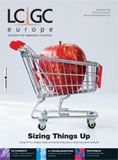Chromatography 2.0 — and Beyond
LCGC Europe has revamped its digital media portfolio to complement the peer-reviewed magazine.
I have been at the helm of LCGC Europe for over a year and it's a pleasure to work on a magazine that is held in such high esteem by its readers. The publication is truly a team effort with the editorial advisory board playing a pivotal role in the magazine's success. I rely on their input to maintain the scientific integrity of the magazine and —despite my impeccable time management skills — the ability to peer-review manuscripts at short notice.

Although I don't have any solid scientific evidence to indicate that readers take the magazine on holiday (or to bed), some respondents in the readership survey did say that they read the magazine travelling to and from work and in their lunch breaks. Readers' feedback plays a crucial role in the editorial direction of the magazine and many of you have stressed that you prefer reading detailed technical information in print — and we will keep delivering the magazine in this format for as long as this demand is there.
LCGC Europe has, however, radically overhauled its digital portfolio. The newly launched global website — www.chromatographyonline.com — combines the contents of LCGC Europe and LCGC North America and allows users to easily access the archive material from both magazines. There are also daily news and feature updates, application notes, product news, multimedia presentations, social networking sites (Facebook, Twitter, LinkedIn) and much more. Social networking sites are, to some extent, in their infancy amongst the chromatography community, but there is great potential for these to become valuable communication tools between separation scientists. Please take the time to check out what's available on the new site.
LGGC Europe's electronic magazine The Column — edited by Janet Kelsey — is now delivered twice a month in a new fast and reader-friendly format containing tips and tricks, commentary from anonymous industry insider Incognito, interviews with scientists at the cutting-edge of chromatography, market analysis, product developments and the latest news and application-based feature stories. Subscription is just a click away at http://bit.ly/subscribetothecolumn.
Also in the pipeline is an inventive e-learning portal called CHROMacademy. You can sample a free taster of some of the modules available at www.chromacademy.com This membership-based service will soon be launched as a comprehensive e-learning site containing interactive e-learning classes, virtual lab tools, peer-reviewed content, industry news, topic sections hosted by experts in specific chromatographic fields and CHROMmunity, where scientists can discuss problems (and solutions) in specific areas.
CHROMacademy will also function as a comprehensive and expanding reference source, as well as a troubleshooting guide to chromatography. A competition to win a free lifetime membership is on-line in the pilot portal as well as the opportunity to let us know what information you need from a chromatography e-learning suite.
LCGC Europe's print and digital portfolio aims to provide readers with the information they need to develop robust analytical methods, improve or repair existing methods and keep them up to date with new developments in technology and instrumentation.
The digital format gives us even more room to cover areas outside the scope of the print magazine and we aim to continually enhance our digital products to make them essential information sources for chromatographers.
If there are any topics that you think we should be covering in more detail, or if you have ideas for a feature or news story please contact me on amatheson@advanstar.com or electronic products editor, Janet Kelsey at jkelsey@advanstar.com.
Your feedback (positive and negative!) is highly valued.

All the best
Alasdair Matheson
Editor — LCGC Europe (Print)

New Method Explored for the Detection of CECs in Crops Irrigated with Contaminated Water
April 30th 2025This new study presents a validated QuEChERS–LC-MS/MS method for detecting eight persistent, mobile, and toxic substances in escarole, tomatoes, and tomato leaves irrigated with contaminated water.

.png&w=3840&q=75)

.png&w=3840&q=75)



.png&w=3840&q=75)



.png&w=3840&q=75)










